A ‘pizzaiolo’ is a word used for the person or chef who makes the pizza.
Pizza, when served as food in high-end restaurants, is served without cutting. They then cut it with a fork and knife the way people usually eat meat.
Pizza is an Italian food made up of the round and stretched foundation of leavened wheat-based bread covered with tomatoes, cheese, and often other toppings (such as pepperoni, onions, shallots, peppers, fruit, sausage, and so on), and cooked at a high temperature, mostly in a wood-fired kiln.
The name ‘pizza’ was first mentioned in a Latin text from the southern region of Italy in Gaeta, on the frontier of Campania, in the 10th century.
Pizza can be purchased fresh or refrigerated, whole or in portion-size slices.
Pizza is an Italian dish that is made of a flattened disc of dough covered with a mixture of olive oil, oregano, tomato, olives, mozzarella or other cheese, and several other additives, baked fast (generally in a business context using a wood-fired oven heated to a high temperature) and served hot.
Methods for overcoming issues such as keeping the tomato sauce from mixing with the bread and making a crust that can be refrigerated and thawed without becoming stiff have been devised.
Frozen pizzas with basic ingredients and self-rising crusts are available. Take-and-bake pizzerias provide another type of unprepared pizza. This pizza is made in the shop and sold to consumers to prepare in their ovens.
Some supermarkets sell ready-made dough, as well as the tomato sauce and other components, to be assembled at home before cooking in an oven. Pizza was introduced in the US by Italian immigrants who opened pizzerias across New York. The first pizzeria was opened by G. Lombardi in Spring Street, Manhattan, New York City.
After reading all about pizza and its different toppings, you would surely enjoy knowing where does pepperoni comes from and where does pastrami come from.
Where does the word pizza come from?
The origin of an early version of modern pizza is known as flatbread. Naples, Italy, was the first place to serve pizza.
It all started with a street vendor and was named Pizza Antica Pizzeria Port'Alba. Pizza is derived from the colloquial 'pinza', which originates from the Latin word ‘pinsere’, which refers to pressing or pounding. Other etymologists believe that the history of pizza is linked to the Lombardic term 'bizzo' or 'pizzo', which means mouthful, and the English word 'bite'.
The word pizza was originally used in Gaeta in AD 997, and afterward in various sections of central and southern Italy. As per the Italian daily La Repubblica, the word was first used in a document written in Gaeta.
The son of a landed aristocracy offers pizza to a local bishop as an annual homage in the report. In the eastern part of America, the words pie or pizza pie are commonly used to refer to a complete pizza.
These words are very rarely used in other areas and cultures beyond the United States.
The use of pie for pizza, on the other hand, extends back to the 1800s. A New York City Tribune story from 1903 stated, 'Pie has long been considered a Yankee dish entirely', and went on to explain a 'pomidore pizza', a dish composed of dough and tomatoes.
'Za' is another version of pizza. This is referred to as trimming: an entire term that has been abbreviated while keeping its intended definition.
Where does Margherita pizza come from?
Pizza Margherita has a famous historical story. It is a delicacy and loved all over the modern world and in many cultures for its components that reflect the hues of the Italian flag.
Red tomato sauce, white mozzarella, and fresh leafy green basil are among the key components. When all of these delectable flavors are put on top of a hand-kneaded pizza foundation, a version of pizza that is immensely beloved is formed.
The Italian city of Naples is usually regarded as the birthplace of pizza and considered as the place where the first pizza was made. Naples was established in the 16th century.
The majority of people were impoverished, therefore pizza, flatbread with toppings supplied by market stalls and suitable for any meal, fulfilled the demands of Neapolitans as a quick and inexpensive supper.
The early pizzas were typically garnished with a variety of ingredients like tomatoes, cheese, peppers, olives, and garlic. Alexandre Dumas, the great French writer, even mentioned the diverse range of pizza toppings in 1843.
The most interesting and widely known legend of the Margherita pizza begins in 1861. In 1889, King Umberto I and Queen Margherita toured Naples, which had previously served as the southern region's capital.
Queen Margherita allegedly became tired of the fancy French spread that was fashionable among European nobility at the period. As a result, she invited Raffaele Esposito, the most well-known pizza chef in Naples at the time, to cook for her.
Esposito was asked by Queen Margherita to create three different pizzas for her. According to legend, Esposito and his wife's initial two pizzas were not to the Queen's liking and she didn't eat them.
Pizza marinara, with garlic, and pizza Napoli, with anchovies, were among them. The Queen selected the third pizza, which was influenced by the colors of the Italian flag.
Esposito promptly titled the pizza after Queen Margherita and requested a royal seal from her. The notice sent out to Esposito by a butler still sits in the pizzeria where he served, Pizzeria Brandi.
What is the most popular topping on pizza?
Almost everyone around the world enjoys pizza. A few toppings, such as pineapple, stir up a lot of discussion and anger in the food community.
But, when it comes to a slice of life that affects the majority of cravings, there are a few toppings among the variety of foods that everyone loves and wants. Pepperoni, basil, and cheese being the most popular toppings since early times.
Pizza’s toppings typically begin with a type of cheese, but from there, you can add on whatever your stomach desires.
Whether you're preparing pizza at home, buying takeout, or going to a local pizza place, selecting the extras may be a time-consuming task. Some pizza toppings like pineapple can split a room, but others are generally respected.
Pepperoni consistently tops the list of America's favorite pizza toppings in poll after poll. When in question, a classic is always a safe bet.
Pepperoni is a kind of meat that is made in America from cured pork and beef that has been flavored with paprika or another chili pepper.
Pepperoni is distinguished by its smooth, slightly smokey texture and brilliant red color.
Pepperoni, thinly sliced, is a common pizza topping in American pizzerias. It wins in the competition of the most popular pizza topping by a landslide.
Most people prefer pepperoni as their pizza topping because it goes so well with the cheese and bread and the flavors of paprika give the pepperoni a distinct and special taste which makes it a favorite.
Turkey meat is also widely used as a replacement, however, in the United States, the use of poultry in pepperoni must be properly labeled.
Curing with nitrates or nitrites (often employed in modern pizza curing agents to guard against botulism and other kinds of microorganism degradation) also adds to the crimson color of pepperoni by interacting with heme in the proteinaceous portions of the meat's myoglobin.
What is America's most loved pizza?

In 2019, Domino's Pizza was the top pizza restaurant chain in the United States, with revenues of around $7.04 billion USD. Pizza Hut came in second and Little Caesars came in third.
In 2019, pizza restaurant sales in the United States of America were over 46 billion US dollars, with restaurant chains contributing approximately 27.8 billion US dollars. Domino's Pizza's revenue climbed between 2018 and 2019, which could be attributed to the corporation upping its advertising costs in the United States.
Considering the organization's growth in the country, Domino's Pizza did not score amongst customers' top three favorite pizza chains in 2018. In 2019, there were 77,724 pizza restaurants in the United States, a 731-unit rise over the preceding year; individual pizzerias accounted for the lion's share of that total, with 41,573 locations.
With 7,482 units in the United States in 2018, Pizza Hut had the most storefronts of the largest pizza companies, each Pizza Hut restaurant produced an average of roughly 738,500 US dollars in 2018.
According to the 2019 Harris Poll EquiTrend Study, Marco's Pizza is America's Most Beloved and Recognized Pizza Company. Marco's Pizza, headquartered in Toledo, Ohio, is one of the country's fastest-growing pizza enterprises. Pasquale Giammarco, an Italian-born entrepreneur, created Marco's in 1978 and flourishes by providing true Italian quality pizza with organic produce.
Was pizza invented in China?
There is a Chinese legend that lets us question the origins of the invention of pizza and credits China as the founder of pizza. According to legend, pizza is a Chinese variant of the scallion pancake, which Marco Polo took back to Italy.
The invention of pizza became known in this way in a comical newspaper piece, which also says that Marco Polo invented cheese fondue when he got trapped in the Alps and wanted to eat Chinese noodle soup.
Marco Polo enjoyed scallion pancakes so much that when he returned to Italy, he sought out cooks willing to make them for him. At a friend's dinner party, he met a chef from Naples and convinced him to try duplicating the delicacy.
After a half-day of failure, Marco Polo proposed that the stuffing be placed on top of the dough rather than within.
By happenstance, the alteration resulted in a meal that was complemented by everyone at the celebration. When the cooks traveled to Naples, they experimented by putting cheese and other toppings to create what is now known as pizza.
According to historical evidence in Europe, Marco Polo did not bring pizza to Europe, and the Mediterranean form existed and developed there much earlier than his era.
Which is the best cheese to add to pizza?
Mozzarella is by far the most popular pizza cheese, and it has soon become the cheese of preference for other kinds as well. Because it is processed, it has a refreshing flavor and a light and smooth texture. Mozzarella cheese was previously manufactured only with buffalo's milk, but it is now also available and made with cow's milk.
When cooking pizza using mozzarella cheese, you have the option of using high or low humidity. High moisture mozzarella has an extremely limited shelf life and must be consumed on the same day it is prepared.
Mozzarella cheese with low moisture stays fresh longer than high moisture mozzarella and has higher salinity and a thicker flavor. This low moisture content also allows it to melt faster when prepared.
Low-moisture mozzarella prepared with whole milk is the optimal choice for pizza, whether used as the sole cheese or as part of a cheese mixture. For Margherita pizzas, use reduced moisture mozzarella and high moisture mozzarella for Neapolitan or Greek pizzas. If using it on its own, slice it thinly and remove any extra moisture out from the cheese.
Because mozzarella is so adaptable, it is the most commonly used cheese in cheese blends. Mozzarella and provolone can be used to form a typical cheese for pepperoni pizza.
Provolone cheese is another favorite. Provolone is a semi-hard Italian cheese that is renowned for blending with other cheeses.
Here at Kidadl, we have carefully created lots of interesting family-friendly facts for everyone to enjoy! If you liked our suggestions for where does pizza come from? Cheesy food history of pizza revealed, then why not take a look at what do armadillos eat, or is tea tree oil safe for dogs?









